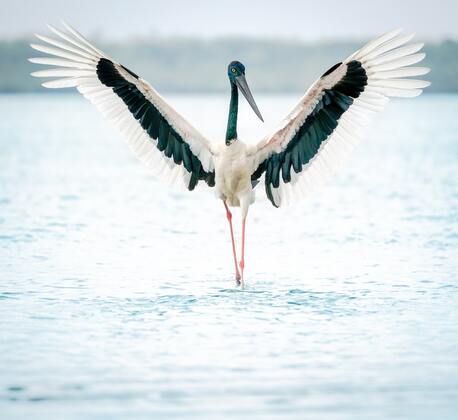There have been recent sightings of a Black-necked stork in Myall Quays and Tea Gardens.
A few years back, there was a nesting pair on the river flats adjoining the upper Myall River just south of Bulahdelah.
|
The black-neck stork grows up to 1.3 metres tall with black and white body plumage, glossy dark green and purple neck and massive black bill with legs long and coral-red in colour, being easily identified from all other Australian birds. It is classified as endangered in NSW but secure in Queensland, WA and Northern Territory. The Black-necked stork does not occur in Victoria, Tasmania or South Australia. The female is distinguished by its yellow eye. Immature birds resemble adults, but the black plumage is replaced by brown and the white plumage is duskier. The species is frequently called the Jabiru, but this is not an Indigenous name, as is often supposed, but is a Brazilian name which refers to a totally different species of stork which occurs in South and Central America. For any sighting of a threatened wildlife species like the Black-necked stork it needs reporting. Please provide as much accurate information as you can, particularly the location (GPS co-ordinates from Google Maps are good), to the NPWS Environment Line by phone on 1300 361 967 or by email to [email protected] . This information is then entered into the NSW Wildlife Atlas. Ian Morphett Myall Koala and environment Group November 2019 Source: Birdlife Australia website |
Distribution The Black-necked Stork is restricted mainly to coastal and near-coastal areas of northern and eastern Australia. Throughout the monsoonal areas of northern Australia, the Black-necked Stork is still widespread, but fewer numbers appear southwards to eastern Australia. Feeding The Black-necked Stork feeds on fish, small crustaceans and amphibians. Most prey is caught by the bird jabbing and seizing it with its large bill. Some food is caught by lunging forward with a large stride or by leaping into the air. Breeding Pairs of Black-necked Storks bond for several years, perhaps for life. The nest is a large platform of sticks and other vegetation, which is placed in a tall tree standing in or near water. Birds are secretive and nest in isolated pairs. There is little courtship, with the exception of some bowing and clapping of bills. The eggs are white and conical and are incubated by both parents who also care for the young together. |


